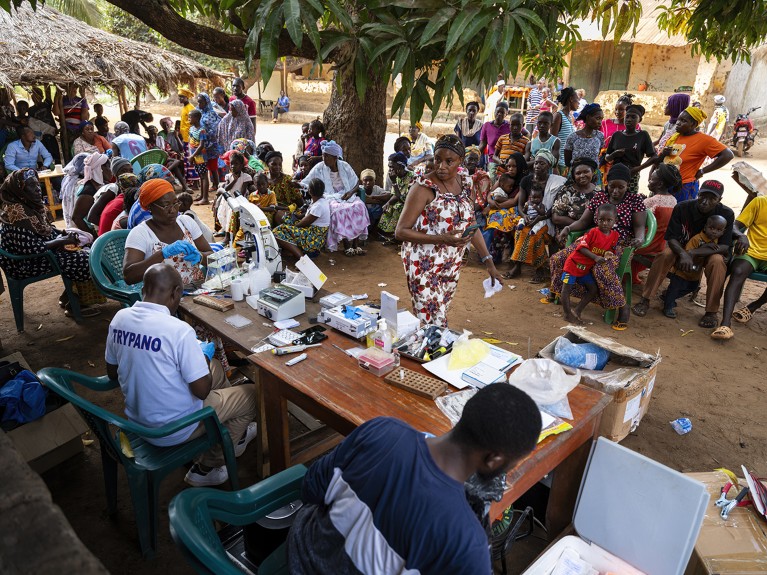
A team of health-care workers screen people for sleeping sickness in the village of Boffa in Guinea.Credit: Brent Stirton/Getty Images for DNDI
Wilfried Mutombo Kalonji wanted to devote his life to doing the most good possible. So, after graduating from medical school in 2004, he moved to Kasansa, a remote village in the Democratic Republic of the Congo (DRC).

Part of Nature Outlook: Neglected tropical diseases
Mutombo was the only physician serving Kasansa’s 11,000 residents. Of all the maladies his patients presented with, late-stage human African trypanosomiasis, or sleeping sickness, was among the diseases he dreaded the most. Caused by protozoan parasites, the disease is almost always fatal if left untreated. But the only medication available to Mutombo was melarsoprol — an arsenic-based drug, which was nearly as terrifying to his patients as the disease itself.
Treatment with melarsoprol consists of a ten-day course of injections that people have described as feeling like “fire in their veins”. The drug’s high toxicity also risks lives: 5–10% of those treated die during the process. Two of Mutombo’s young male patients were among those that have succumbed. “I could imagine what their parents were telling themselves,” he says: “‘This doctor has killed our son.’”
Mutombo never wanted to repeat that experience. So, in 2006, he began collaborating with the Drugs for Neglected Diseases Initiative (DNDi), an organization based in Geneva, Switzerland, that was working on eliminating the disease. Such efforts — spearheaded by the World Health Organization (WHO) and by various public-health authorities in Africa — have resulted in a 97.5% reduction in sleeping-sickness cases over the past two decades.
Mutombo, who is now head of the DNDi’s clinical operations team in the DRC, has co-led several clinical trials searching for safer, more effective treatments for sleeping sickness. One promising single-dose drug in development, acoziborole, could give physicians the ability not just to treat people with a confirmed infection, but also to interrupt transmission by treating people who might have been exposed to the parasites. In parallel to medical interventions, entomologists have developed better methods for reducing the population of tsetse flies (Glossina spp.), the insects that transmit the parasite to humans.
These efforts are showing signs of success. Fewer than 1,000 cases of sleeping sickness have been reported annually in Africa over the past seven years, down from a peak of almost 40,000 cases in 1998. In 2012, the WHO set a goal of stopping transmission of the form of the disease that occurs in western and central Africa by 2030. Seven countries have already reduced cases of sleeping sickness to less than one case per 10,000 residents, and several others are on the cusp of doing so. If these efforts succeed, “it would be the first time we’ve eliminated a fatal human disease from the planet without a vaccine”, says Philippe Neau, head of the neglected tropical diseases programme at Foundation S in Paris — an organization funded by pharmaceutical company Sanofi, which produces most of the treatments for sleeping sickness.
Still, a declaration of victory would be premature. Without constant vigilance, the disease has a track record of re-emerging — even in places where it was thought to have been wiped out. One reason is that the parasites have evolved to play a game of hide-and-seek with the immune system by constantly changing their ‘surface coat’ to evade antibodies. “There has been a lot of progress toward elimination, but if we stopped now, sleeping sickness would come back, and it could affect millions of people,” says Gerardo Priotto, a medical officer at the WHO. “The tsetse fly is still there.”
A cryptic infection
Table of Contents
Sleeping sickness is caused by two types of unicellular parasite: Trypanosoma brucei gambiense and Trypanosoma brucei rhodesiense. Key differences exist between the sub-species. T. b. rhodesiense occurs in eastern and southern Africa, mainly in savannah ecosystems, and it can live in a range of wild and domestic animals. In humans, it causes a fast-acting disease that develops in weeks to months. T. b. gambiense, however, occurs mainly near water bodies in rural parts of western and central Africa. It causes around 90% of sleeping-sickness cases, and humans are its main known reservoir — a fact that means elimination could be possible.
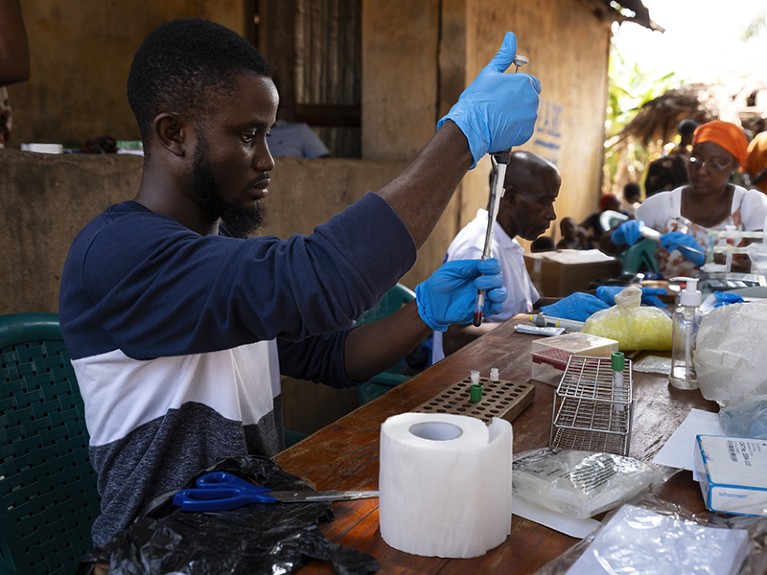
A health worker tests for sleeping-sickness parasites in a blood sample.Credit: Brent Stirton/Getty Images for DNDI
Most of the efforts against sleeping sickness have focused on T. b. gambiense, which takes months or even years to cause acute symptoms, and diagnosis during the initial stages of infection can be challenging. Symptoms usually include a non-specific fever and headache, which can be misdiagnosed as malaria. While the person is given malaria treatments, T. b. gambiense grows in their system.
Without diagnostic tests, T. b. gambiense’s identity becomes clear only once it makes its way to its final destination — the brain. It then begins to cause the unusual patterns of sleep for which the accompanying disease is named. “The person’s rhythm of sleep gets broken into pieces,” says Olaf Valverde, a physician at DNDi. “They can fall asleep during the day, just talking to someone, and have bouts of insomnia by night.”
Once the density of parasites in the brain is high enough, the disease enters its second stage. Individuals show telltale neurological symptoms, including disinhibition, extreme talkativeness, exaggerated laughter and confusion. At this stage, without treatment “there’s almost no escape”, Priotto says. “You will die.”
Because there is little commercial interest in developing treatments for neglected tropical diseases, such as sleeping sickness, the WHO approached two pharmaceutical companies — Sanofi in Paris and Bayer in Leverkusen, Germany — to find a charity-based path forward. From the start of the initiative, everyone knew that the arsenic-based treatment melarsoprol needed to be replaced with something safer. As Priotto says, “a worse treatment is difficult to imagine.”
In 2003, the DNDi was established to find new, better treatments for sleeping sickness and other neglected tropical diseases. After evaluating more than 700 candidate molecules from various sources, DNDi researchers identified fexinidazole, which had been discovered by a German chemical company in the 1970s but shelved because of a lack of commercial viability. DNDi and Sanofi collaborated to develop the treatment.
Clinical trials, which began in 2012, took longer than expected. War broke out in the Central African Republic, forcing the team to abandon a site there. Remote areas in the DRC — the country where more than half of all sleeping sickness cases now occur — were also a challenge to reach and to work in, Mutombo says. “The health facilities there are in bad states, without water, electricity, Internet or laboratories.”
After more than a decade of effort, in December 2018, fexinidazole for the T. b. gambiense strain of the disease received a ‘positive opinion’ from the European Medicines Agency — a form of approval for drugs that will be used outside the European Union — and started to be administered in March 2020. It now accounts for about 70% of sleeping-sickness treatments, Neau says. In December 2023, fexinidazole also gained approval for treating the acute strain of the disease found in east and southern Africa.
Although a great improvement over melarsoprol, fexinidazole is still not ideal. For one, the drug is not as effective in the late stages of the disease as it is in the early stage. Moreover, individuals must take the drug for ten days. Side effects can include nausea and vomiting that is so severe that some people stop the medication. Ensuring that people take the full dose requires medical supervision. This means people must go to the nearest hospital, which can be hours away. Some countries also require someone to accompany the patient to the hospital, increasing the burden on the family. “In these rural areas, going to the hospital has a big impact,” Mutombo says. “This disease makes poor people poorer.”
“You can’t obligate someone to go for treatment,” says Jean-Mathieu Bart, an investigator based in Conakry, Guinea, with the French National Research Institute for Sustainable Development in Marseille. “Sometimes it takes one year before we succeed in convincing the person to go for treatment, and during this year, they can contaminate other people in the village.”
While fexinidazole was being developed, DNDi researchers continued to look for something better. They found one promising molecule under patent by Anacor Pharmaceuticals (acquired by multinational pharmaceutical firm Pfizer in 2016), but it did not enter the brain in sufficient quantities. So they teamed up with scientists from Anacor, as well as Pace University in New York City and Scynexis, a biotechnology company in Jersey City, New Jersey, to increase the compound’s ability to accumulate in the brain.
The resulting drug, acoziborole, is an oral medication. Valverde lauds it for its “beautiful feature” of being a one-and-done treatment —three tablets are taken in a single dose. Unlike fexinidazole, it also seems effective for people at all stages of the disease. Clinical trials in the DRC and Guinea have produced promising results1. At 18 months after treatment with the drug, around 96% of 167 people with late-stage sleeping sickness were still parasite-free, as were all 41 people with early- or intermediate-stage disease. The only notable side effects so far have been mild to moderate headaches. Based on the evidence, Priotto says, “it’s like a dream drug”.
Working with Sanofi, Valverde and his colleagues hope to gain a positive opinion from the European Medicines Agency by 2026, and to start treating people the following year. Once acoziborole is available, Bart adds, it “will be a game changer”.
Kill the messenger
Pharmaceuticals are essential for eliminating sleeping sickness, but vector control is also a crucial tool. The good news here is that killing the tsetse flies that carry the parasite is straightforward because of their unusual reproductive strategy. Females mate just once and produce a single live-birthed larva every ten days. As a result, “you only have to kill something like 4% of the population per day to drive the population to extinction,” says entomologist Stephen Torr at the Liverpool School of Tropical Medicine, UK.
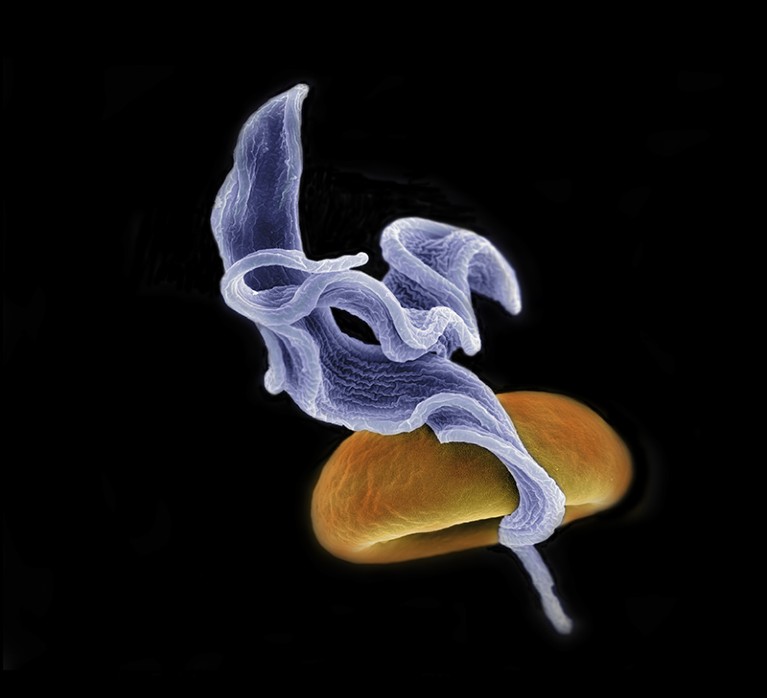
The Trypanosoma brucei parasite (blue) causes sleeping sickness.Credit: IKELOS GmbH/Dr. Christopher B. Jackson/SPL
It took entomologists a while, however, to work out how to lure the flies into a trap to kill them. The insects that transmit the less common T. b. rhodesiense parasite — the savannah tsetse fly — were not a major problem to bait because they are attracted to odours. But the riverine tsetse flies that are the vector for the more widespread T. b. gambiense have no such affinity to aromas, and proved much more elusive. Then in 2008, Torr and his colleagues ran a series of experiments2 and found that the flies are drawn to small blue objects.
Torr and his colleagues first created a small target made of a blue cloth, about the size of a handkerchief, that they covered in insecticide. The flies circled the target — but only about 40% landed on it and were exposed to the insecticide. So the researchers added a parallel panel of very fine black net, also covered in pesticide. This design worked: flies drawn to blue targets collided with the netting, which they could not see, and then flew away having received a lethal dose of poison.
Even after developing the “tiny targets”, as the researchers call them, it took several years for the importance of vector control to gain widespread acceptance. The WHO and other international medical teams saw vector control “as very time-consuming and not cost-effective,” Bart says.
He and his colleagues in Guinea persisted, however, and in 2012 they set up tiny targets in a coastal community affected by sleeping sickness. The method’s effectiveness was unexpectedly confirmed when Ebola broke out in 2013. Violence against medical teams swept the country, driven by misconceptions that the virus was being brought to villages by health workers. Safety concerns caused sleeping-sickness testing and treatment efforts across Guinea to be put on hold.
Vector-control activities, however, continued unabated. When Bart and his colleagues were able to resume medical activities, they found that sleeping sickness had begun to increase in the country — from around 78 cases per year in 2013 to 139 cases in 2017. The exception, however, was the small area where vector control had been maintained. Cases there had remained low.
Research shows that tiny targets can “massively” accelerate elimination of the disease, adds Inaki Tirados, a medical entomologist at the Liverpool School of Tropical Medicine. In Chad, for example, where vector control was also initiated early, scientists estimated that it accounted for 70% of the decline in new sleeping-sickness cases between 2013 and 2015 (ref. 3). Although vector control is not helpful for people who have already been infected with T. b. gambiense, “it is the only method that can provide protection from getting sleeping sickness”, Torr says.
Forecasting the future
Judging solely by case count, efforts to eliminate sleeping sickness caused by T. b. gambiense seem to have stalled (see ‘Elimination of sleeping sickness is in sight’). But the numbers reported are deceptive, Priotto says, because rather than reflecting the true level of disease transmission, they show the level of case-finding activities that result in diagnoses.
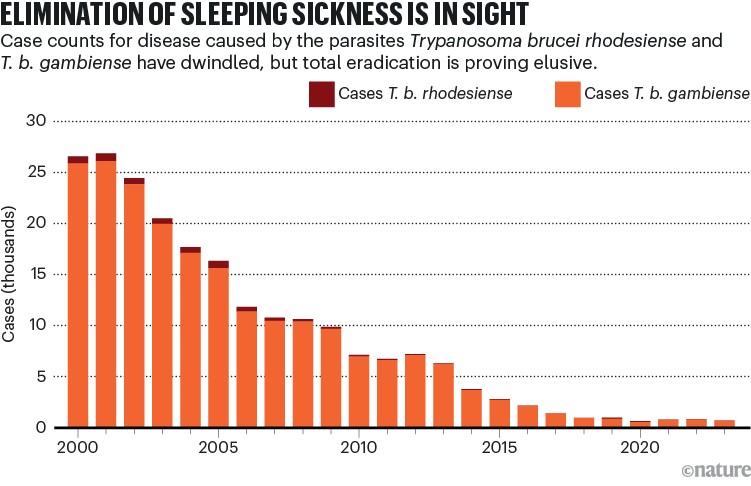
During the COVID-19 pandemic, for example, many case-finding efforts ground to a halt, so sleeping-sickness case numbers, in turn, seem to have plummeted in 2020. And the increase in case numbers after COVID-19 restrictions were lifted represent greater efforts to find and treat instances of the disease, Priotto says. Many villages that used to have high levels of sleeping sickness are now transmission-free, and health-care authorities have been able to move on to other villages that they previously did not have the resources to access. “Even if the numbers are in a plateau, elimination is advancing,” Priotto says.
Success should not be taken for granted, however. Civil unrest can disrupt progress. In the Central African Republic, for example, health-care workers have been unable to access a northern region for years because government-associated medical staff are at risk of attack from rebel groups. Separatist groups are also active in southwestern Cameroon, preventing essentially all sleeping-sickness control activities in the region.
And the closer countries come to elimination, the more time, money and effort are needed to find and treat each remaining case — a phenomenon that risks ‘donor fatigue’, Bart says. “It’s difficult to convince people that we need as much money to detect one case as we used to need to detect 10–20 cases.”
One way to stretch elimination efforts is to spend money as wisely as possible. To that end, Kat Rock, a mathematical epidemiologist at the University of Warwick, UK, is leading a team of modellers to create tailored elimination strategies for five African countries. In the DRC, for example, where vector control is limited, Rock and her colleagues identified areas where tiny targets would probably be most effective for enhancing medical interventions4,5. As well as providing actionable insights for elimination efforts, modelling can also help to forecast how well elimination efforts are likely to fare. “We want to understand how long this very concerted effort for sleeping sickness will have to go on,” Rock says.
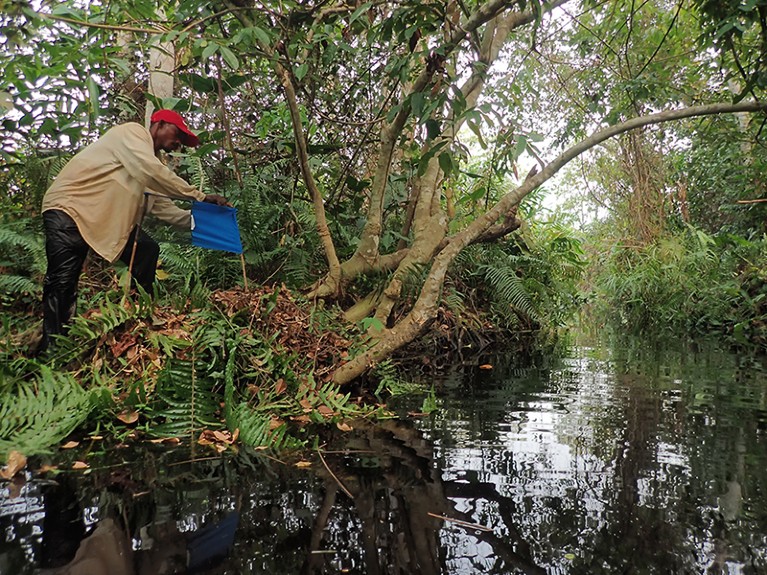
A blue ‘tiny target’ coated in insecticide is used to control populations of tsetse flies.Credit: Sophie Dunkley
Despite this progress, however, the ultimate goal of vanquishing sleeping sickness permanently — known as eradication — remains elusive. Unknowns are numerous, but include whether the parasite might have an as-yet-undiscovered animal reservoir, or be able to persist in some healthy human carriers who never develop symptoms but remain infectious. Screening and diagnostic tools are imperfect, and the many obstacles of working in rural Africa make it unlikely that every case will ever be found and treated. “In this context,” Priotto says, “we don’t dare talk about eradication.”
